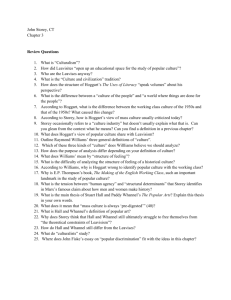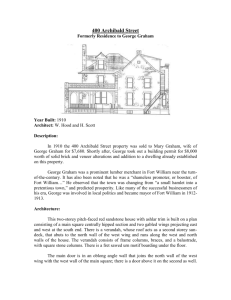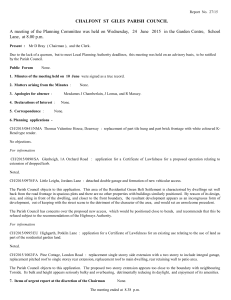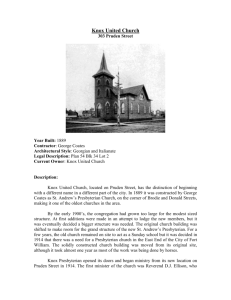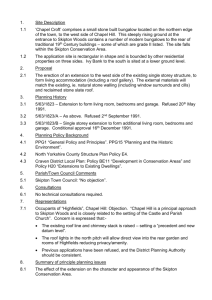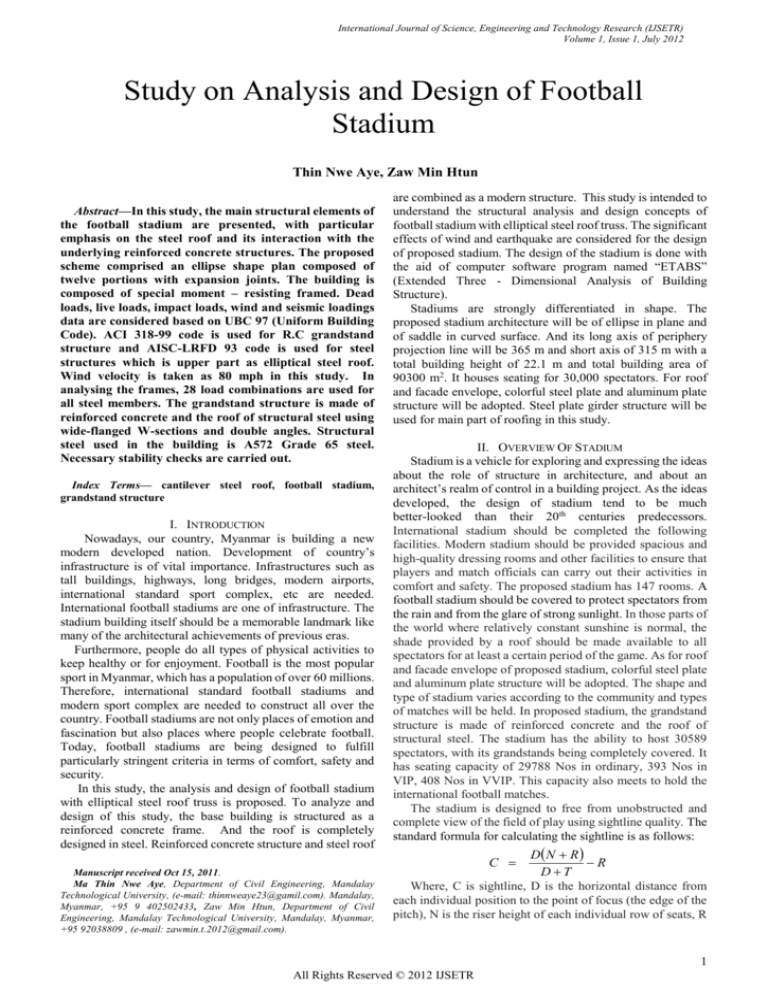
International Journal of Science, Engineering and Technology Research (IJSETR)
Volume 1, Issue 1, July 2012
Study on Analysis and Design of Football
Stadium
Thin Nwe Aye, Zaw Min Htun
Abstract—In this study, the main structural elements of
the football stadium are presented, with particular
emphasis on the steel roof and its interaction with the
underlying reinforced concrete structures. The proposed
scheme comprised an ellipse shape plan composed of
twelve portions with expansion joints. The building is
composed of special moment – resisting framed. Dead
loads, live loads, impact loads, wind and seismic loadings
data are considered based on UBC 97 (Uniform Building
Code). ACI 318-99 code is used for R.C grandstand
structure and AISC-LRFD 93 code is used for steel
structures which is upper part as elliptical steel roof.
Wind velocity is taken as 80 mph in this study. In
analysing the frames, 28 load combinations are used for
all steel members. The grandstand structure is made of
reinforced concrete and the roof of structural steel using
wide-flanged W-sections and double angles. Structural
steel used in the building is A572 Grade 65 steel.
Necessary stability checks are carried out.
Index Terms— cantilever steel roof, football stadium,
grandstand structure
I. INTRODUCTION
Nowadays, our country, Myanmar is building a new
modern developed nation. Development of country’s
infrastructure is of vital importance. Infrastructures such as
tall buildings, highways, long bridges, modern airports,
international standard sport complex, etc are needed.
International football stadiums are one of infrastructure. The
stadium building itself should be a memorable landmark like
many of the architectural achievements of previous eras.
Furthermore, people do all types of physical activities to
keep healthy or for enjoyment. Football is the most popular
sport in Myanmar, which has a population of over 60 millions.
Therefore, international standard football stadiums and
modern sport complex are needed to construct all over the
country. Football stadiums are not only places of emotion and
fascination but also places where people celebrate football.
Today, football stadiums are being designed to fulfill
particularly stringent criteria in terms of comfort, safety and
security.
In this study, the analysis and design of football stadium
with elliptical steel roof truss is proposed. To analyze and
design of this study, the base building is structured as a
reinforced concrete frame. And the roof is completely
designed in steel. Reinforced concrete structure and steel roof
are combined as a modern structure. This study is intended to
understand the structural analysis and design concepts of
football stadium with elliptical steel roof truss. The significant
effects of wind and earthquake are considered for the design
of proposed stadium. The design of the stadium is done with
the aid of computer software program named “ETABS”
(Extended Three - Dimensional Analysis of Building
Structure).
Stadiums are strongly differentiated in shape. The
proposed stadium architecture will be of ellipse in plane and
of saddle in curved surface. And its long axis of periphery
projection line will be 365 m and short axis of 315 m with a
total building height of 22.1 m and total building area of
90300 m2. It houses seating for 30,000 spectators. For roof
and facade envelope, colorful steel plate and aluminum plate
structure will be adopted. Steel plate girder structure will be
used for main part of roofing in this study.
II. OVERVIEW OF STADIUM
Stadium is a vehicle for exploring and expressing the ideas
about the role of structure in architecture, and about an
architect’s realm of control in a building project. As the ideas
developed, the design of stadium tend to be much
better-looked than their 20th centuries predecessors.
International stadium should be completed the following
facilities. Modern stadium should be provided spacious and
high-quality dressing rooms and other facilities to ensure that
players and match officials can carry out their activities in
comfort and safety. The proposed stadium has 147 rooms. A
football stadium should be covered to protect spectators from
the rain and from the glare of strong sunlight. In those parts of
the world where relatively constant sunshine is normal, the
shade provided by a roof should be made available to all
spectators for at least a certain period of the game. As for roof
and facade envelope of proposed stadium, colorful steel plate
and aluminum plate structure will be adopted. The shape and
type of stadium varies according to the community and types
of matches will be held. In proposed stadium, the grandstand
structure is made of reinforced concrete and the roof of
structural steel. The stadium has the ability to host 30589
spectators, with its grandstands being completely covered. It
has seating capacity of 29788 Nos in ordinary, 393 Nos in
VIP, 408 Nos in VVIP. This capacity also meets to hold the
international football matches.
The stadium is designed to free from unobstructed and
complete view of the field of play using sightline quality. The
standard formula for calculating the sightline is as follows:
D N R
R
D T
Where, C is sightline, D is the horizontal distance from
each individual position to the point of focus (the edge of the
pitch), N is the riser height of each individual row of seats, R
C
Manuscript received Oct 15, 2011.
Ma Thin Nwe Aye, Department of Civil Engineering, Mandalay
Technological University, (e-mail: thinnweaye23@gamil.com). Mandalay,
Myanmar, +95 9 402502433, Zaw Min Htun, Department of Civil
Engineering, Mandalay Technological University, Mandalay, Myanmar,
+95 92038809 , (e-mail: zawmin.t.2012@gmail.com).
1
All Rights Reserved © 2012 IJSETR
International Journal of Science, Engineering and Technology Research (IJSETR)
Volume 1, Issue 1, July 2012
is the vertical height between the persons eye level and the
point of focus (pitch level) and T is the depth of each
individual row of seats. Because the shape of the stadium is a
true ellipse, no row of seats is a straight line. The auditoriums
are arranged as in bowl shape to free from unobstructed and
complete view of the field play using sightline quality.
Modern football stadiums should be designed so that all
spectators are safe and comfortable, have a perfect view of the
pitch and have easy access to toilets and refreshment
facilities. Access and exit to and from the seats, both in
normal and emergency situations are carefully planned in this
stadium All spectators should be seated. Seats must be
individual, affixed to the structure and comfortably shaped,
with backrests of a minimum height of one foot to provide
support. Seats should be unbreakable, fireproof and capable
of withstanding the rigours of the prevailing climate without
undue deterioration or loss of color. Seats for VIPs should be
wider and more comfortable and should be located at the
centre of the field and separated from the rest of the seating
areas. To achieve reasonable leg-room, a minimum distance
of 85cm from backrest to backrest is recommended.
The spectators should be able to find their way easily to
their seats. All seats should be numbered in a way that makes
them clearly, easily and immediately identifiable. Spectators
should not have to stoop to look at obscure, faded and
miniscule seat number plates while others wait behind them,
impatient and frustrated. It is important that the whole entry
process is not stressful or unnecessarily slow. When arriving
at an unfamiliar stadium with a ticket for, say, Sector A, Row
11, Seat 9, the spectator should find the route to the seat
clearly marked and easily identifiable. Stadium must be
provided sufficient toilet facilities consisting of a single WC
and sink for both sexes.
III. OBJECTIVE OF STUDY
The objectives of this study are as follows:
(1)To analyze and design the superstructure of football
stadium with cantilever elliptical steel roof truss
(2)To realize the design concept for reinforced concrete
frame football stadium
IV.
PREPARATION FOR DESIGN CALCULATION
A. Structural Framing System
This structure is designed based on UBC - 97. It is located
in Mandalay area which is UBC seismic zone 4. The stadium
has not only 863 ft of long axis of periphery line but also 700
ft of short axis. The grandstand has a total building height of
22.1 m and total building area of 90300m2. ETABS software
is used to analyze the superstructure.
B. Material Properties of Structure
Material properties of structure are as follows:
1) Material Property of Concrete
i.
Analysis property data
- Weight per unit volume of
Concrete
= 150 pcf
- Modulus of elasticity, Es
= 3605 ksi
- Poisson's ratio
= 0.2
- Coefficient of thermal
expansion
= 5.5x10-6in/in
per °F
ii.
Design property data
-Specified concrete compressive
strength, f’c
-Bending reinforced yield stress, fy
-Shear reinforced yield stress, fys
2) Material Property of Steel
i.
Analysis property data
-Modulus of elasticity, Es
-Poisson’s ratio
ii.
Design property data
-Minimum yield stress, Fy
-Minimum tensile strength, Fu
= 4 ksi
= 50 ksi
= 50 ksi
=29,000 ksi
= 0.3
= 65 ksi
= 80 ksi
C. Loading Consideration
Loads are forces tending to effect and produce
deformations, stresses or displacement in structure. Stadiums
are subjected to several types of loads. They are gravity loads
and lateral loads. Gravity loads are caused by the gravitational
pull of the earth and act in vertical direction. Gravity loads are
further classified as dead loads and live loads. The two
primary lateral loads on stadiums are wind and earthquakes.
Design load combinations are also used.
1) Dead Loads: Dead loads consist of the weight of all
material and fixed equipments incorporated into the building.
-unit weight of concrete
= 150 pcf
- 9 " thick brick wall weight
= 100 pcf
- 4.5 " thick brick wall weight
= 55 pcf
- superimposed dead load for
finishing
= 25 psf
-weight of aluminium and glass
wall
= 20 psf
-weight of lift
= 3 tons
2) Live loads: Live loads shall be the maximum loads
expected by the intended use or occupancy. They may be
fully or partially in place or not present at all.
-live load of handrail and
guards
= 50 psf
-live load on public area
= 100 psf
-live load on office area
= 50 psf
-live load on stores
= 100 psf
-live load on lobbies and similar
areas
= 100 psf
-live load on stair case
= 100 psf
-live load on landing
= 100 psf
-live load on stages and
platforms
= 125 psf
-live load on lift
= 100 psf
-live load on roof
= 5 psf
3) Impact Load: Grandstands, stadiums, and similar
assembly structures may be subjected to loads caused by
crowds swaying in unison, jumping to its feet, or stomping.
Designers are cautioned that the possibility of such loads
should be considered.
-impact dead load on inclined auditorium = 60 psf
-impact live load on inclined auditorium = 90 psf
2
All Rights Reserved © 2012 IJSETR
International Journal of Science, Engineering and Technology Research (IJSETR)
Volume 1, Issue 1, July 2012
4) Wind Load: The determination of wind design force on
a structure is basically a dynamic problem because a building
will be continually affected by gusts and other aerodynamic
force. Required Data in designing for wind load:
- Exposure type
= Type B
- Basic wind velocity
= 80 mph
- Total height of building
= 91 ft (up to
top of roof)
- Method used
= Normal
Force
Method
- Windward coefficient
= 0.8
- Leeward coefficient
= 0.5
- Importance Factor
= 1.0
5) Earthquake Load: Nowadays, the structures are
designed to resist in an earthquake according to lateral force
design. Effects on earthquakes on structures are as follows:
(i) Seismic importance factor, I
(ii)Seismic zone factor, Z
(iii)Soil profile types, S
(iv)Seismic source type
(v)Near - source factors, Na and Nv
(vi)Seismic response coefficients, Ca and Cv
(vii) Response Modification Factor, R
- Seismic zone
= zone (4)
- Seismic source type
=A
- Soil profile type
= SD
- Structural system
= SMRF
- Seismic zone factor
= 0.4
- Seismic importance factor, I
= 1.0
- Response modification factor, R = 8.5
-Seismic response coefficient, Ca = 0.44 Na
-Seismic response coefficient, Cv =0.64 Nv
- CT value
= 0.03
V.
Figure1 describes that typical base plan and selected
symmetric portions for whole stadium with twelve expansion
joints. Three-dimensional view for whole structure analyzing
by ETABS software is illustrated in Figure 2.
Figure2. Three-Dimensional View of Football Stadium
ANALYSIS RESULTS OF FOOTBALL STADIUM
The design results of football stadium are carried out (18)
types of load combinations based on ACI (318-99) code for
grandstand structure and (22) types of load combinations
according to AISC-LRFD (93) for cantilever steel roof. The
proposed scheme comprised an ellipse shape plan composed
of twelve portions with expansion joints. There are five
portions for whole stadium to be symmetric. They are portion
1, 2, 3 for other portion and VIP 1, 2 portions for VIP portion.
In this paper, the design results for portion 1(one-twelfth),
portion 3 (one-twelfth) and VIP 1 portion (one-twelfth) are
carried out.
Figure3. 3D view of football stadium (portion 1= one twelfth
of all)
Figure1. Typical Base Plan and Selected Symmetric Portions
for Whole Stadium
Figure4. 3D view of football stadium (portion 3= one twelfth
of all)
3
All Rights Reserved © 2012 IJSETR
International Journal of Science, Engineering and Technology Research (IJSETR)
Volume 1, Issue 1, July 2012
Figure8. Main cantilever truss of VIP 1 portion
Figure5. 3D view of football stadium (VIP 1 portion= one
twelfth of all)
In Figure 3, 4 and 5, three-dimensional view of portion 1,
portion 3 and VIP 1 portion are described. Figure 6, 7 and
8show main cantilever truss of portion 1, portion 3 and VIP 1
portion. Sample roof trusses of portion1, portion 3 and VIP 1
portion are described in figure 9, 10 and 11.
Figure6. Main cantilever truss of portion1
Figure9. Sample roof truss of portion 1
Figure7. Main cantilever truss of portion 3
Figure10. Sample roof truss of portion 3
4
All Rights Reserved © 2012 IJSETR
International Journal of Science, Engineering and Technology Research (IJSETR)
Volume 1, Issue 1, July 2012
TABLE II
DESIGN RESULT OF STEEL ROOF
Name
Vertical Truss
Top, Bottom
Chord
Truss
Member
W10x45
W10x54
W10x100
W10x112
W10x88
W10x100
W10x112
W12x120
Material
Steel
Steel
Steel
Steel
Steel
Steel
Steel
Steel
2L4x3x1/4x3/8SSLB
2L4x4x3/8
2L4x4x5/8
Steel
Steel
Steel
VI. STABILITY CHECKING OF SUPERSTRUCTURE
Figure11. Sample roof truss of VIP 1 portion
A. Modeling of the structure
The proposed superstructure is designed as Special
Moment Resisting Frame.
Total height
= 91 ft (up to top of roof)
Length
= major axis 863 ft
minor axis 700 ft
Shape of the structure
= elliptical shape
Location
= zone-4
Type
= roofed stadium
(with cantilever roof truss)
B. Design results of structure
The football stadium is constructed with concrete for
column(C), beam (B) and slabs. The cantilever steel roof is
built with wide-flanged W-sections and double angles for top
chords, bottom chords and truss.
Wide-flanged W-sections are the most commonly used
sections. The wide-flanged shape is designed by the nominal
depth and weight per foot.
TABLE I
DESIGN RESULT OF GRANDSTAND STRUCTURE
Name
Column
Beam
Slab
Member
Material
C24′′x24′′
C24′′x28′′
C24′′x48′′
C26′′x26′′
Concrete
B9′′x12′′
B12′′x18′′
B12′′x20′′
B12′′x24′′
B14′′x20′′
B14′′x24′′
B14′′x28′′
B18′′x24′′
B18′′x34′′
B18′′x36′′
Aud: slab (7in tk)
Other slab ( 6in tk)
Roof slab (0.125in tk)
Concrete
Concrete
Concrete
Concrete
Concrete
Concrete
Concrete
Concrete
Concrete
Concrete
Concrete
Concrete
Concrete
Concrete
Concrete
Concrete
Steel plate
According to UBC 97, checking for storey drift, checking
for P- Δ effect, checking for overturning, checking for sliding,
checking for torsion are needed to be safe for the structure.
There are five portions to check stability of the stadium. But
stability checks of portion 1, portion 2 and VIP1 portion are
described as sample in this study.
A. Checking for storey drift
Story drift is lateral displacement of one level of structure
relative to the level below. In UBC-97, for structure having a
fundamental period of greater than 0.7 second, the calculated
storey drift shall not exceed 0.020 times the storey height. The
storey drift shall not exceed 0.025 times the storey height for
structures having the fundamental period of 0.7 second or
lesser. These limitations are to ensure a minimum level of
stiffness so as to control inelastic deformation and possible
instability.
ΔM= 0.7 R Δs
Where,
ΔM = Maximum displacement
R = Response modification factor= 8.5
Δs = Deformation
According to analysis results by ETABS software, the
value of storey drifts for proposed portions are within story
drifts limitation. Thus, the superstructure is stable.
B. Checking for P- Δ Effect
According to UBC-97, the resulting member forces and
moments and storey drifts included by P- Δ effects shall be
considered in the evaluation of overall structural frame
stability. In seismic zone 3 and 4, P- Δ effects need not be
considered when the storey drift (Δ) is less than or equal to
0.02 hx/R. So, the proposed stadium is located in seismic zone
4. The maximum drift ratio of stadium is satisfied with the
limitation, we can neglect P- Δ effect.
C. Checking for Overturning Moment
Every structure shall be designed to resist the overturning
effects caused by earthquake forces. The distributed of
earthquake forces over the height of a structure causes to
experience overturning moment. The UBC-97 requires that
every designed structure be able to resist overturning effect
included by earthquake forces. Based on analysis result of
stadium, the safety factor is not only 30.25 for X- direction
5
All Rights Reserved © 2012 IJSETR
International Journal of Science, Engineering and Technology Research (IJSETR)
Volume 1, Issue 1, July 2012
but also 14.01 for Y- direction for portion 1. In portion 3, the
safety factor of X- direction is 20.72 and that of Y- direction is
12.56. For VIP1 portion, factor of safety for both X and
Y-directions are 8.18 and 14.25 respectively. So, the
superstructure of stadium is able to resist overturning effect as
the safety factors for X and Y directions are greater than 1.5.
D. Checking for Sliding
Factor of safety for sliding is the ratio of the resistance due
to friction to sliding force. From UBC-97, the safety factor of
sliding must be greater than 1.5. For the proposed stadium, the
factors of safety for sliding in both X and Y- directions are
4.23 and 4.43 in portion1. For portion 3, safety factor for both
X and Y-directions are 2.55 and 4.07 respectively. In VIP1
portion, factor of safety in X- direction is 7.35 and that of Ydirection is 8.64. Thus, the structure will be safe for sliding.
E. Checking for torsion
Accidental torsion that occurs due to uncertainties in the
building’s mass and stiffness distribution must be added to the
calculated eccentricity. The torsional effect is checked
between the most two distant points in a structure. In this
stadium, the safety factors for X and Y-directions are 1.17 and
1.09 for portion1, and 1.2 and 1.05 for portion 3 and 1.185
and 1.134 for VIP1 portion. The torsional irregularity can be
neglected because the safety factors of stadium are within the
limit.
Figure 13.Comparison of Storey Drift in X- direction in
portion 3
It can be found that storey drift values of SPECY are
increased about 44% than that of SPECX in storey 1. But in
storey 3, storey drift due to SPECY is a slight drift than that of
SPECX.
VII. COMPARISON OF STABILITY RESULTS
In this study, the design results for members are carried
out load combinations based on ACI 318-99 code. The
comparisons of structural performance results in response
spectrum analysis are graphically described.
A. Comparison of Storey Drift in X direction
This section discusses the relative story drift value for
response spectrum analysis and all these values are
graphically represented in Figure 12, 13 and 14.
Figure 14.Comparison of Storey Drift in X- direction in
VIP 1 portion
In Figure 13, maximum storey drift ratio is found in
SPECY of storey 1 and minimum storey drift ratio is seen in
SPECX of storey 4.
B. Comparison of Storey Drift in Y direction
This section also discusses the relative storey drift value
for response spectrum analysis and all these values are shown
in figure 15, 16 and 17.
Figure 12.Comparison of Storey Drift in X- direction in
portion 1
It can be found that for portion 1, storey drift value for
SPEC Y is absolutely five times that of SPEC X.
Figure 15.Comparison of Storey Drift in Y- direction in
portion 1
6
All Rights Reserved © 2012 IJSETR
International Journal of Science, Engineering and Technology Research (IJSETR)
Volume 1, Issue 1, July 2012
It can be seen that storey drift ratio was considered much
less about 5 times for SPECX than the SPECY in all stories.
In comparison of storey shear in X- direction, the storey
shear in SPECX is less than nearly 4 times than that of
SPECY for all stories.
Figure 16.Comparison of Story Drift in Y- direction in
portion 3
According to Figure 16, storey drift ratio due to SPECY
is greater than absolutely 10 times that of SPECX in storey 2,
3 and 4. However, in storey 1, storey drift ratio in SPECX is
less than about 6 times of SPECY.
Figure 19.Comparison of Story Shear in X- direction in
portion 3
In comparison of storey shear in X- direction, maximum
value of 715.64 kips is occurred at storey 1 in SPECX.
Figure 20.Comparasion of Storey Shear in X- direction in
VIP 1 portion
Figure 17.Comparasion of Storey Drift in Y- direction in
VIP 1 portion
Figure 17 can be seen that the storey drift ratio of SPECY
is increased over 70% of that of SPECX in all stories.
The figure shows storey shear values for response
spectrum analysis. Maximum storey shear is occurred at
storey 3 and approximately 1100 kips in SPECY.
C. Comparison of Storey Shear in X-direction
This section shows storey shear for three portions in each
storey level and shown in figure 18, 17 and 20.
D. Comparison of Storey Shear in Y- direction
This section gives storey shear in each storey level for
three portions and shown in figure 21, 22 and 23.
<
Figure 18.Comparison of Storey Shear in X- direction in
portion 1
Figure 21.Comparison of Storey Shear in Y- direction in
portion 1
7
All Rights Reserved © 2012 IJSETR
International Journal of Science, Engineering and Technology Research (IJSETR)
Volume 1, Issue 1, July 2012
Figure 21 can be seen that maximum storey shear is
occurred in SPECY at storey 1 and minimum storey shear is
founded in SPECX at storey 2.
In comparison of storey moment in X- direction, storey
moment values of SPECY is 45243.39 kips-in and it is five
times larger that of SPECX.
Figure 22.Comparison of Storey Shear in Y- direction in
portion 3
Figure 25.Comparison of Storey Moment in X- direction
in portion 3
This figure shows comparison of storey shear in response
spectrum analysis for portion 3. The values of storey shear for
SPECY are sharply increased than that for SPECX.
This figure shows storey moment values for portion 3.
Maximum value for SPECX of 155637.608 kip-in is occurred
at storey 1 and it is twice of SPECY. But storey moment of
SPECX is four times greater that of SPECY at remain stories.
Figure 23.Comparison of Storey Shear in Y- direction in
VIP 1 portion
It can be founded that the value of storey shear reached a
new peak of just over700 kips on SPECY of storey 3.
E. Comparison of Storey Moment in X- direction
This section discusses the storey moment value of three
portions and it is represented on figure 24, 25 and 26.
Figure 24.Comparison of Storey Moment in X- direction in
portion 1
Figure 26.Comparison of Storey Moment in X- direction
in VIP 1 portion
In comparison of storey moment in X- direction in VIP1
portion, storey moment value of SPECY is increased
approximately 13 times that of SPECX.
F. Comparison of Storey Moment in Y- direction
This section represents the storey moment value for
response spectrum analysis for each storey and it is shown in
figure 27, 28 and 29.
Figure 27.Comparison of Storey Moment in Y- direction
in portion 1
8
All Rights Reserved © 2012 IJSETR
International Journal of Science, Engineering and Technology Research (IJSETR)
Volume 1, Issue 1, July 2012
This figure can be founded that storey moment of SPECX
is decreased about 5 times that of SPECY.
Figure 28.Comparison of Storey Moment in Y- direction in
portion 3
We can be seen in this figure 28 that the values of storey
moment of SPECX are increased significantly to each storey
at 15 times that of SPECY.
stability of the superstructure are within the limitation, so the
structure is stable. Firstly, the proposed stadium is analyzed
with static analysis. If the static condition is satisfied, the
model is also analyzed with response spectrum analysis for
dynamic approach.
In comparison of analysis results, maximum storey drift
ratios due to SPECX and SPECY can be found at storey 1 in
all portions for both directions. Maximum storey shear among
all portions is occurred at storey 3 of VIP 1 portion and
approximately 1100 kips due to SPECY in X-direction. In
comparison of storey shear for Y- direction, it can be founded
that the value of storey shear reached a new peak of just
over700 kips on SPECY of storey 3among all portions. The
minimum storey moment among all portions can be seen at
storey 2 of portion1 and nearly 700 kips-in due to SPECX in
X- direction. The maximum storey moment in Y-direction can
be seen at storey 4 for portion1 and at storey 1 for portion 3
and VIP 1 portion.
It is hoped that the study here will get some knowledge to
build a safe economical structure.
ACKNOWLEDGMENT
Figure 29.Comparison of Storey Moment in Y- direction in
VIP 1 portion
In figure 29, storey moment in SPECY has almost 15 times
as many as storey moment in SPECX for all stories.
<<,
Firstly, the author thanks her parents for educating her
from her childhood till now. The author is very thankful to,
Dr. Myint Thein, Rector, Mandalay Technological University
and Dr. Kyaw Moe Aung, Associate Professor and Head of
Civil Engineering Department, Mandalay Technological
University, for her kind advice and permission to carry out
this paper. The author would like to express her special
appreciation to her supervisor, Dr. Zaw Min Htun, Lecturer,
Department of Civil Engineering, Mandalay Technological
University. The author also wishes to reveal her thanks to all
teachers from Civil Engineering department at Mandalay
Technological University who guided and helped during the
preparation of the study. Moreover, the author thanks to Max
Myanmar Construction Group which helped in collecting data
required for this study.
The author also wishes to thank all her friends for their
helps and advices on her studying. Finally, the author would
like to express grateful thanks to all teachers for their
supports, kindness and unconditional love.
VIII. DISCUSSIONS AND CONCLUSIONS
In this study, the stadium with reinforced concrete
grandstand structure and cantilever steel roof is analyzed and
designed for the superstructure by ETABS software, ACI
(318-99), AISC-LRFD 1993.The design of superstructure for
wind speed 80 mph was done. As the structure is located in
high seismic risk zone 4, dynamic analysis is considered in the
proposed stadium according to UBC- 97.
Wide-flanged W-sections and double angles are used for
top chords, bottom chords and truss of cantilever roof. In this
study, both of bolted connection and welded connection were
used for cantilever roof. To make the structural analysis,
preliminary estimation of the member sizes were chosen as a
first step. Cross sections were chosen to meet the design
requirements according to the design procedure. P- Δ effect,
story drift, overturning and sliding, torsion were also checked
in the design calculation. All the checking carried out for the
REFERENCES
[1]
[2]
[3]
Anonymous: Football Stadiums, Technical Recommendation and
requirements, FIFA, Fe'de'ration Internationale de Football
Association, 4 th Edition, Switzarland, 2007.
Uniform Building Code, Volume 2. "Structural Engineering Design
Provisions". 1997, 8th Ed. International Conference of Building
Officials.
Charles G. Salmon, John E. Johnson, "Steel Structures Design and
Behavior”, 3rd Edition, Harper Collons Publishers, 1986.
9
All Rights Reserved © 2012 IJSETR



